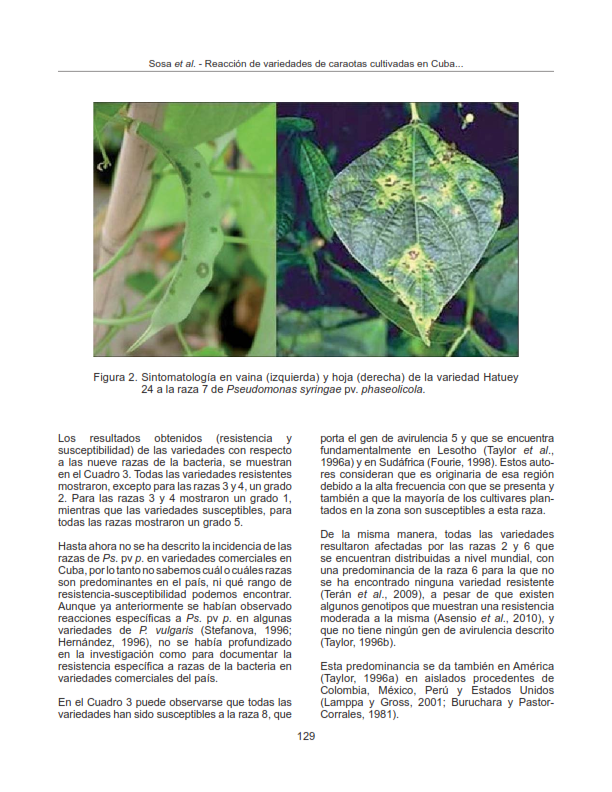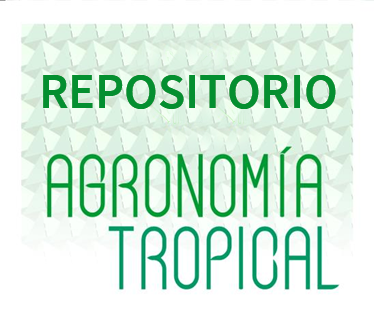Reacción de variedades de caraotas cultivadas en Cuba a la enfermedad bacteriana de la grasa
Resumen
La caraota, Phaseolus vulgaris L., es ampliamente cultivada en regiones tropicales y sub-tropicales, considerada una fuente de proteínas, carbohidratos, fibras y minerales. La enfermedad bacteriana conocida como la grasa causada por Pseudomonas syringae pv. phaseolicola (Ps. pv p.) tiene gran incidencia a nivel mundial. La amplia variabilidad patogénica de esta bacteria obliga a buscar continuamente fuentes de resistencia. El objetivo de este trabajo fue determinar la reacción de doce variedades de caraota cultivadas en Cuba a diferentes razas de Ps. pv p. Las plantas fueron inoculadas con nueve razas de Ps. pv p. y evaluadas en invernadero. Se estudió la respuesta a la infección de las variedades en hojas y vainas. Se evidenció tres clases de respuesta a la bacteria: cultivares susceptibles a todas las razas, cultivares solo resistentes a las razas 3, 4 y cultivares resistentes a las razas 1, 5, 7 y 9. Los resultados de este estudio indicaron que los diferentes genotipos de caraota tienen diferentes niveles de resistencia a Ps. pv p. con lo cual se pudiera usar la piramidación de genes con métodos apropiados para proporcionar una resistencia duradera.
Descargas
Citas
• Araya, C. M. y R. Araya 2000. Avances en la selección de fuentes de resistencia a las principales enfermedades del frijol común (Phaseolus vulgaris L.) en Costa Rica. Agronomía Mesoamericana. 11(2):25-29.
• Ariyarathne, H. M., D. P. Coyne, G. Jung, P. W. Skroch, A. K. Vadaver, J. R. Steadman, P. N. Miklas and M. J. Basset. 1999. Molecular mapping of disease resistance genes for halo blight, common bacterial blight, and bean common mosaic virus in a segregating population of common bean. Journal of the American Society for Horticultural Science. 124(6):654-662.
• Arnold, D. L., H. Lovell, R. Jackson and J. W. Mansfield. 2011. Pseudomonas syringae pv. phaseolicola: From ‘has bean’ to supermodel. Molecular Plant Pathology. 12(7):617-627.
• Asensio, C. 1995. Bacteriosis en judías en Castilla y León: identificación de la variación patogénica de Pseudomonas syringae pv. phaseolicola y factores que influyen en su desarrollo. Estudio de la herencia de la resistencia a la raza 1 de Ps. pv. phaseolicola. Tesis Doctoral. Universidad de León, España.
• Asensio, C., S Asensio, M. de la Rosa C. Manzanera, A. Ibeas, and L. de la Rosa. 2010. Resistance to halo blight, common bacterial blight, and bacterial brown spot in Spanish common bean core collection. Annual Report. Bean Improvement Cooperative. 53:110-111.
• Balzarini, M. y J. Di Rienzo. 2004. Info-Gen: Software para análisis estadístico de datos genéticos. Facultad de Ciencia Agropecuarias. Universidad Nacional de Córdoba. Argentina.
• Beebe, S. E., J. Rengifo, E. Gaitan, M. C. Duque and J. Tohme. 2001. Diversity and Origin of Andean Landraces of Common Bean. Crop Science. 41(3):854-862.
• Bozkurt, I. and S. Soylu. 2011. Determination of responses of different bean cultivars against races of Pseudomonas syringae pv phaseolicola, causal agent of halo blight of bean. Euphityca. 179(3):417-425.
• Buruchara, R. A. and M. A. Pastor Corrales. 1981. Variation virulence of Pseudomonas syringae pv. phaseolicola on beans in Colombia. In: Proceedings of the Fifth International Conference on Plant Pathogenic Bacteria. Cali, Colombia CIAT. pp. 341-351.
• Coyne, D. P. and M. L. Schuster. 1974. Inheritance and linkage relations of reaction to Xanthomonas phaseoli (E F Smith) Dowson (common blight), stage of plant development and plant habit in Phaseolus vulgaris L. Euphytica. 23(2):195-204.
• Crosse, J. E. 1966. Epidermiological relations of the Pseudomonas pathogens of deciduous fruit trees. Annual Review of Phytopathology. 4:291-310.
• Cuartero, J. 1993. Resistencia genética a enfermedades y plagas. Presente y futuro. Hortofruticultura. 4(3):41-46.
• Faure, A. B., T. Hernández, M. Sánchez y M. O. Rodríguez. 1997. Fríjol común: Mejoramiento Genético: In: Memorias 25 Aniversario. Antonio Casanovas Morales (ed.). pp. 39-40.
• Fett, W. F. and L. Sequeira. 1981. Further characterization of the physiologic races of Pseudomonas glycinea. Canadian Journal Botany. 59(3):283-287.
• Fourie, D. 1998. Characterization of halo blight races on dry beans in South Africa. Plant Diseasess. 82(3):307-310.
• Galván, M. Z., M. B. Aulicino, G. Medina and P. A. Balatti. 2001. Genetic diversity among Northwestern Argentinian cultivars of common bean (Phaseolus vulgaris) as revealed by RAPD markers. Genetic Resources of Crop Evolution. 48(3):251-260.
• Gepts, P., J. L. Aragão, E. de Barros, M. Blair, R. Brondani, W. Broughton, I. Galasso, G. Hernández, J. Kami, P. Lariguet, P. McClean, M. Melotto, P. Miklas, P. Pauls, A. Pedrosa- Harand, T. Porch, F. Sanchez, F. Sparvoli and K. Yu. 2008. Genomics of Phaseolus Beans, a Major Source of Dietary Protein and Micronutrients in the Tropics. Chapter 5. In: P.H. Moore, R. Ming (eds.).2008. Genomics of Tropical Crop Plants. pp. 113-143.
• González C., A. I. 1996. Estudio in vivo e in vitro de la resistencia a Pseudomonas syringae pv. phaseolicola en judías (Phaseolus vulgaris L.) y caracterización molecular de la variación patogénica. Tesis Doctoral. Universidad de León. España.
• González C., A. I., M. Pérez de la Vega, M. L. Ruiz and C. Polanco. 2003. Analysis of the argK-tox Gene Cluster in Nontoxigenic Strains of Pseudomonas syringae pv. phaseolicola. Applied and Environmental Microbiology. 69(8):4.979-4.982.
• Guerra, A. G., N. Lastres, E. Hernández and L. Castiñeiras. 1994. Evaluation of common bean (P. vulgaris L.) germplasm for resistance to main bean diseases in Cuba. Plant Genetic Resources Newsletter No. 99. pp. 41-42.
• Hale, C. N. and J. D. Taylor. 1973. Races of Pseudomonas phaseolicola causing halo blight of beans in New Zealand. Journal of Agricultural Research. 16(1):147-149.
• Harper, S., N. Zewdie, I. R. Brown and J. W. Mansfield. 1987. Histological, physiological and genetical studies of the responses of leaves and pods of Phaseolus vulgaris to three races of Pseudomonas syringae pv. phaseolicola and Pseudomonas syringae pv. coronafaciens. Physiology and Molecular Plant Pathology. 31(2):153-172.
• Hernández, T. 1996. El cultivo del frijol (Phaseolus vulgaris L.) y la bacteriosis común (Xanthomonas campestris pv. phaseoli) en Cuba. In: PROFRIJOL. Primer Taller sobre bacteriosis común del frijol. Universidad de Puerto Rico. pp. 199-201.
• Innes, N. L., J. Conway and J. D. Taylor. 1984.Resistance to halo-blight in the Cambridge accessions V4604 and V 4058 of Phaseolus bean. Ann. Appl. Biol. 104(2):307-314.
• Jenner, C., E. Hitching, J. Mansfield, K. Walters, P. Betteridge, D. Teverson and J. Taylor.1991. Gene for gene interactions between Pseudomonas syringae pv. phaseolicola and Phaseolus. Molecular Plant Microbe Interactions. 4(6):553-562.
• Keen, N. T. 1990. Gene-for-gene complementarity in plant-pathogen interactions. Annual Review of Genetics. 24(1):247-263.
• Lamppa, R. S. and P. L. Gross. 2001. Identification of races of Pseudomonas syringae pv. phaseolicola presents in North Dakota. North Harvest Bean Growers Association. Disponible en línea: https://bit.ly/390r2yV
• Mabagala, R. B. and A. W. Saettler. 1992. Races and survival of Pseudomonas syringae pv. phaseolicola in Tanzania. Plant Diseases. 76(7):678-682.
• Mahuku, G. S., C. E. Jara, V. C. H. Cajiao and S. Beebe. 2002. Sources of resistance to Colletotrichum lindemuthianum in the secondary gene pool of Phaseolus vulgaris and in crosses of primary and secondary gene pools. Plant Diseases. 86(12):1.383-1.387.
• Mansfield, J., C. Jenner, R. Hockenhull, M. A. Bennett and R. Stewart 1994. Characterization of avrPphE, a gene for cultivar-specific avirulence from Pseudomonas syringae pv. phaseolicola which is physically linked to hrpY, a new hrp gene identified in the halo- blight bacterium. Molecular Plant Microbe Interactions. 7(6):726-739.
• Michaels, T. E., T. H. Smith, J. Larsen, A. D. Beattie and K. P. Pauls. 2006. OAC Rex common bean. Canadian Journal of Plant Science. 86(3):733-736.
• Rico A., R. López, C. Asensio, M. Aizprún, C. Asensio-Sánchez and J. Murillo. 2003. Nontoxigenic strains of Pseudomoas syringae pv. phaseolicola are a main cause of halo blight of beans in Spain and escape current detection methods. Phytopathology. 93(12):1.553-1.559.
• Rivas, L. A., J. Mansfield, G. Tsiamis, R. W. Jackson and J. Murillo. 2005. Changes in race- specific virulence in Pseudomonas syringae pv. phaseolicola are associated with a chimeric transposable element and rare deletion events in a plasmid-borne pathogenicity island. Appl. Environ. Microbiol. 71(7):3.778-3.785.
• Rodríguez, O., B. Faure, R. Benítez, R. M. Carballo and J. Capote. 1999. Advances in the study of common bean resistance to bacterial diseases in Cuba. Agronomía Mesoamericana. 10(1):55-58.
• Singh, S. P. 1999. Production and utilization. In: Common beans: Research for crop improvement. A. van Schoonhoven y O. Voysest (eds.). CAB Int. Wallingford, UK & CIAT. Cali, Colombia. pp. 119-162.
• Singh, S. P. and C. G. Muñoz. 1999. Resistance to common bacterial blight among Phaseolus species and common bean improvement. Crop Science. 39(1):80-89.
• Singh, S. P. 2001a. Use of germplasm in breeding. In: Handbook on evaluation of Phaseolus germplasm. C. de la Cuadra, A. M. de Ron y R.
• Schachl (eds.). PHASELIEU-FAIR-PL97-3463. MBG-CSIC. España. pp. 65-77.
• Singh, S. P. 2001b. Broadening the Genetic Base of Common Bean Cultivars: A review. Crop Science. 41(6):1.659-1.675.
• Singh, S. P., M. C. German and H. Terán. 2001. Registration of common bacterial blight resistant dry bean germplasm VAX1, VAX3 y VAX4. Crop Science. 41(1):275-276.
• Singh, S. P., H. Terán, H. F. Schwartz, K. Otto and M. Lemac. 2009. Introgressing White Mold Resistance from Phaseolus Species of the Secondary Gene Pool into Common Bean. Crop Science. 49(5):1.629-1.637.
• Sneath, P. H. A. and R. R. Sokal. 1973. Numerical Taxonomy. The principles and practice of numerical classifications.W.H. Freeman and Co., S. Francisco. 573 p.
• Stefanova, M. 1996. Aspectos etiológicos y epidemiológicos de la bacteriosis común (Xanthomonas campestris pv. phaseoli) del frijol en Cuba. In: Primer Taller Internacional sobre bacteriosis común del frijol. PROFRIJOL. Universidad de Puerto Rico. pp. 121-129.
• Taylor, J. D., D. M. Teverson, D. J. Allen and M. Pastor-Corrales. 1996a. Identification and origin of races of Pseudomonas syringae pv. phaseolicola from Africa and other bean growthing areas. Plant Pathology. 45(3):469-478.
• Taylor, J. D., D. M. Teverson and J. H. C. Davis. 1996b. Sources of resistance to Pseudomonas syringae pv. phaseolicola races in Phaseolus vulgaris. Plant Pathology. 45(3):479-485.
• Taylor, J. D., J. R. Bevan, I. R. Crute and S. L.Reader. 1989. Genetic relationship between races of Pseudomonas syringae pv. pisi and cultivars of Pisum sativum. Plant Pathology. 38(3):364-375.
• Taylor, J. D., N. L. Innes, C. L. Dudley and W.Griffiths. 1978. Sources and inheritance of resistance to halo-blight of Phaseolus beans. Ann. Appl. Biol. 90(1):101-110.
• Thomas, M. D. and J. V. Leary. 1980. A new race of Pseudomonas glycinea. Phytopathology. 70:310-312.
• Terán, H., M. Lema, D. Webster and S. Singh. 2009. 75 years of breeding pinto bean for resistance to diseases in the United States. Euphytica. 167(3):341-351.
• Valladares Sánchez, N. E., D. P. Coyne and M. L. Schuster. 1979. Differential reaction of leaves and pods of Phaseolus germplasm to strains of Xanthomonas phaseoli and transgressive segregation for tolerance from crosses of susceptible germplasm. Journal of American Society Horticultural Science. 104(5):648-654.
• Voysest, O. 2000. Mejoramiento genético del fríjol (Phaseoulus vulgaris L.): legado de variedades de América latina 1930-1999. CIAT. Colombia. 195 p.
• Walker, J. C. and P. N. Patel. 1964. Splash dispersal and wind as factors in epidemiology of halo-blight of bean. Phytopatology. 54(2):140-141.
• Yoshii, K., G. E. Galvez, S. R. Temple, S. H. Orozco, P. Masaya and L. F. Aldana. 1980. Release of three new Guatemalan bean varieties tolerant to golden mosaic virus. Annual Report of the Bean Improvement Cooperative. Bean Improvement Cooperative. 23:122-124.
• Zaiter, H. Z. and D. P. Coyne. 1984. Testing inoculation methods and sources of resistance to the halo blight bacterium (Pseudomonas syringae pv. phaseolicola) in Phaseolus vulgaris. Euphytica. 33(1):133-141.
• Zapata, M. 1997. Identificación de razas de Xanthomonas campestris pv. phaseoli en hojas de P. vulgaris. Agronomía Mesoamericana. 8(1):44-52.
• Zaumeyer, W. J. and H. R. Thomas. 1957. A monographic study of bean diseases and methods for their control. U.S.D.A. Agr. Tech. Bull 868. 255 p.





